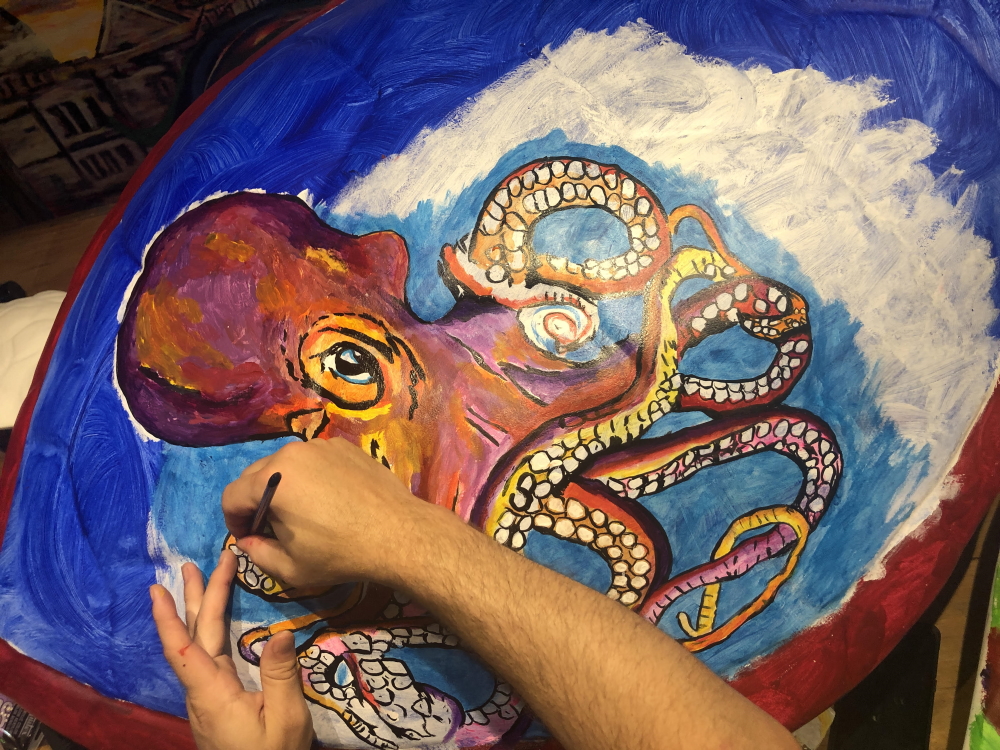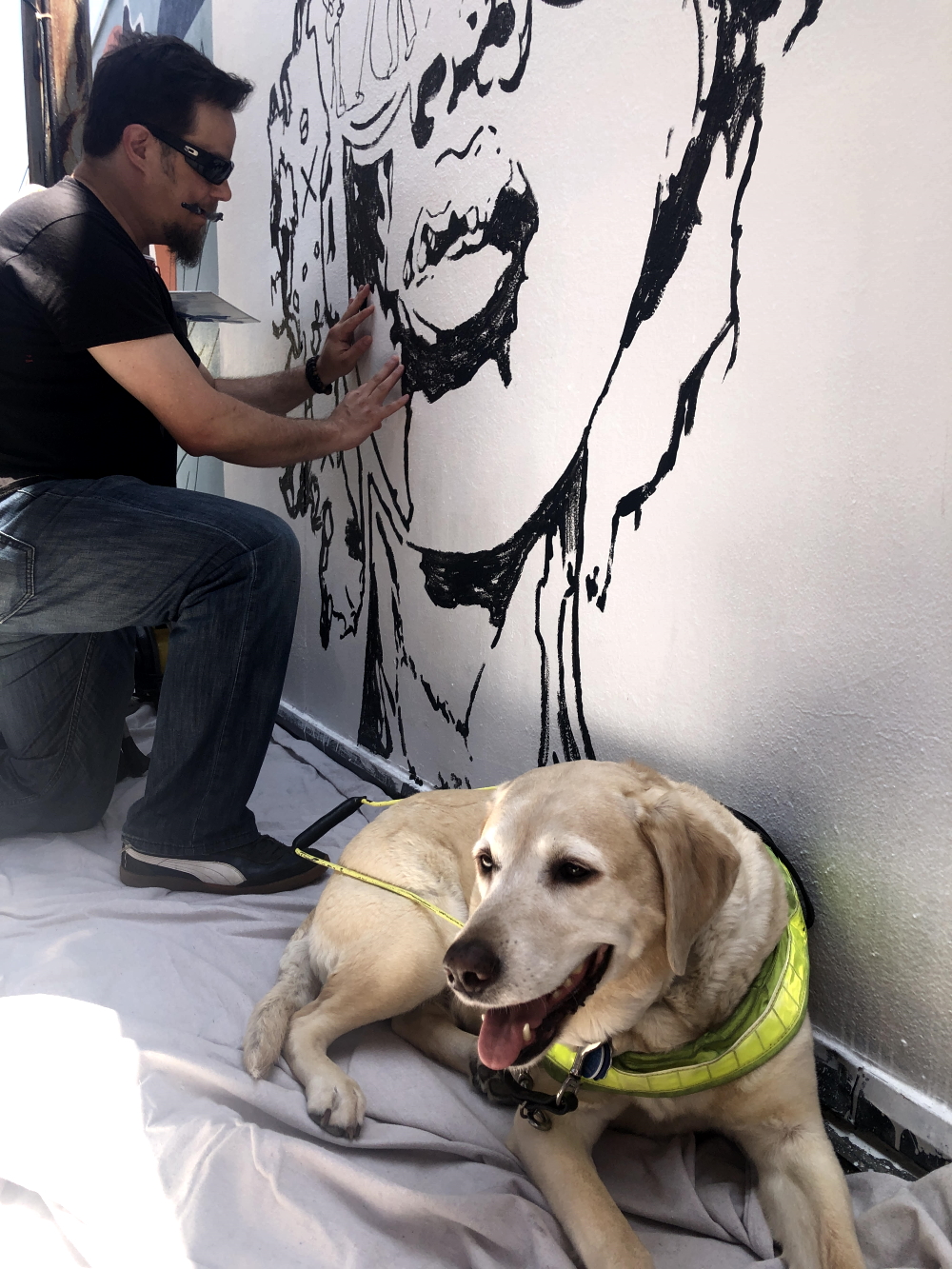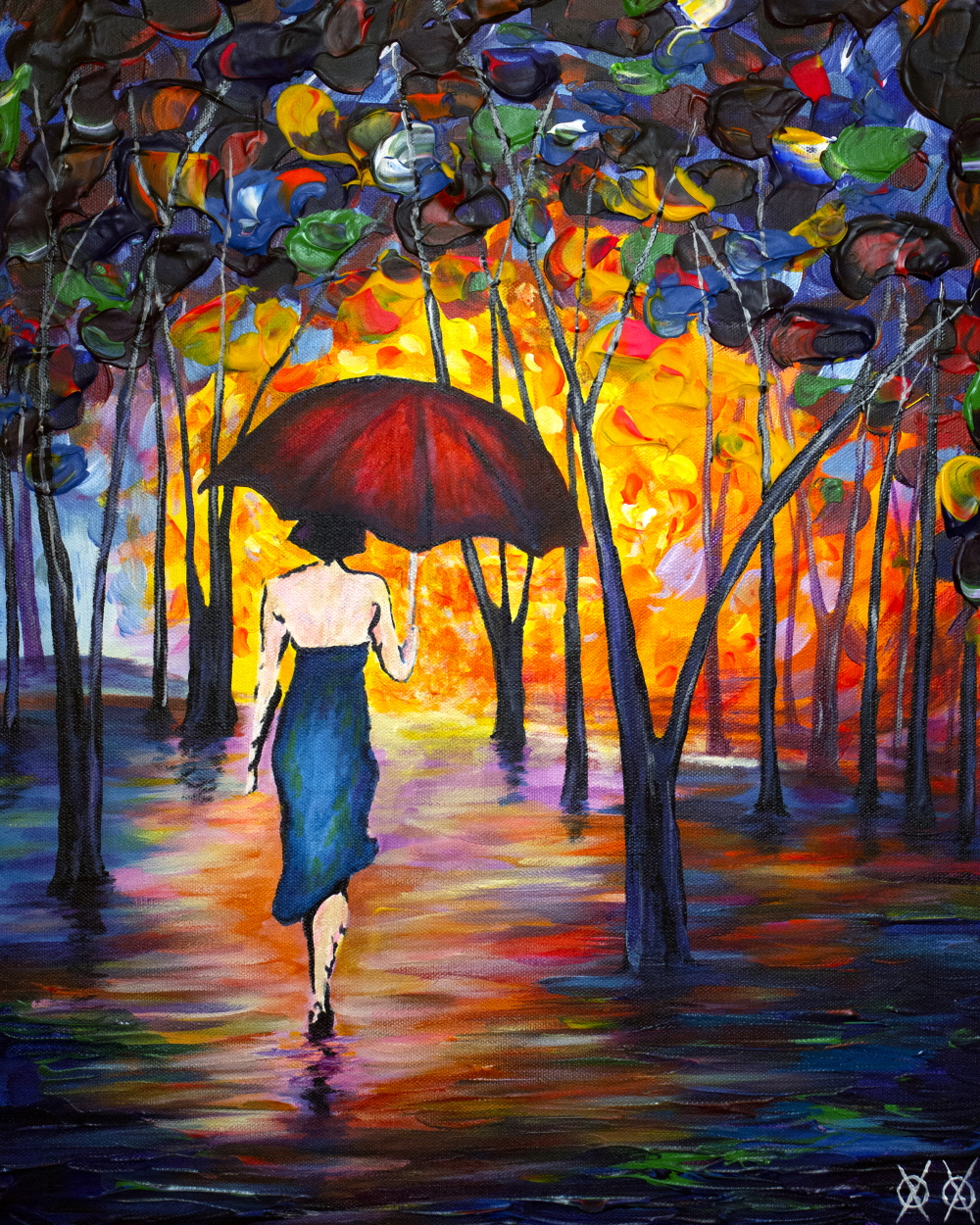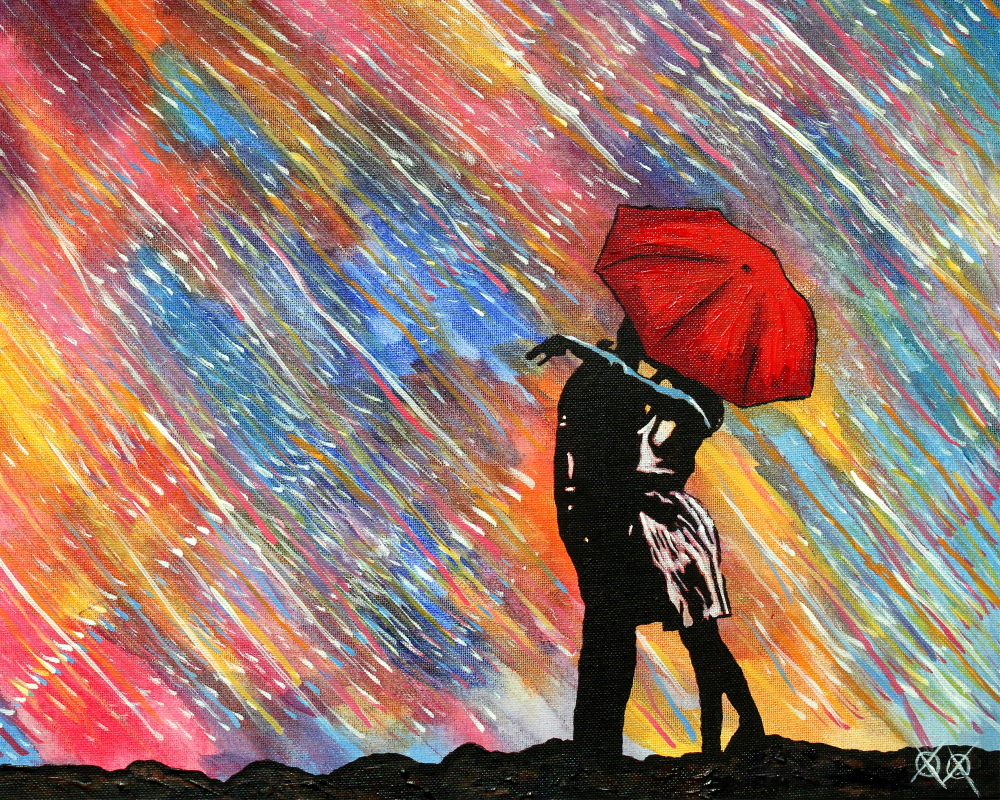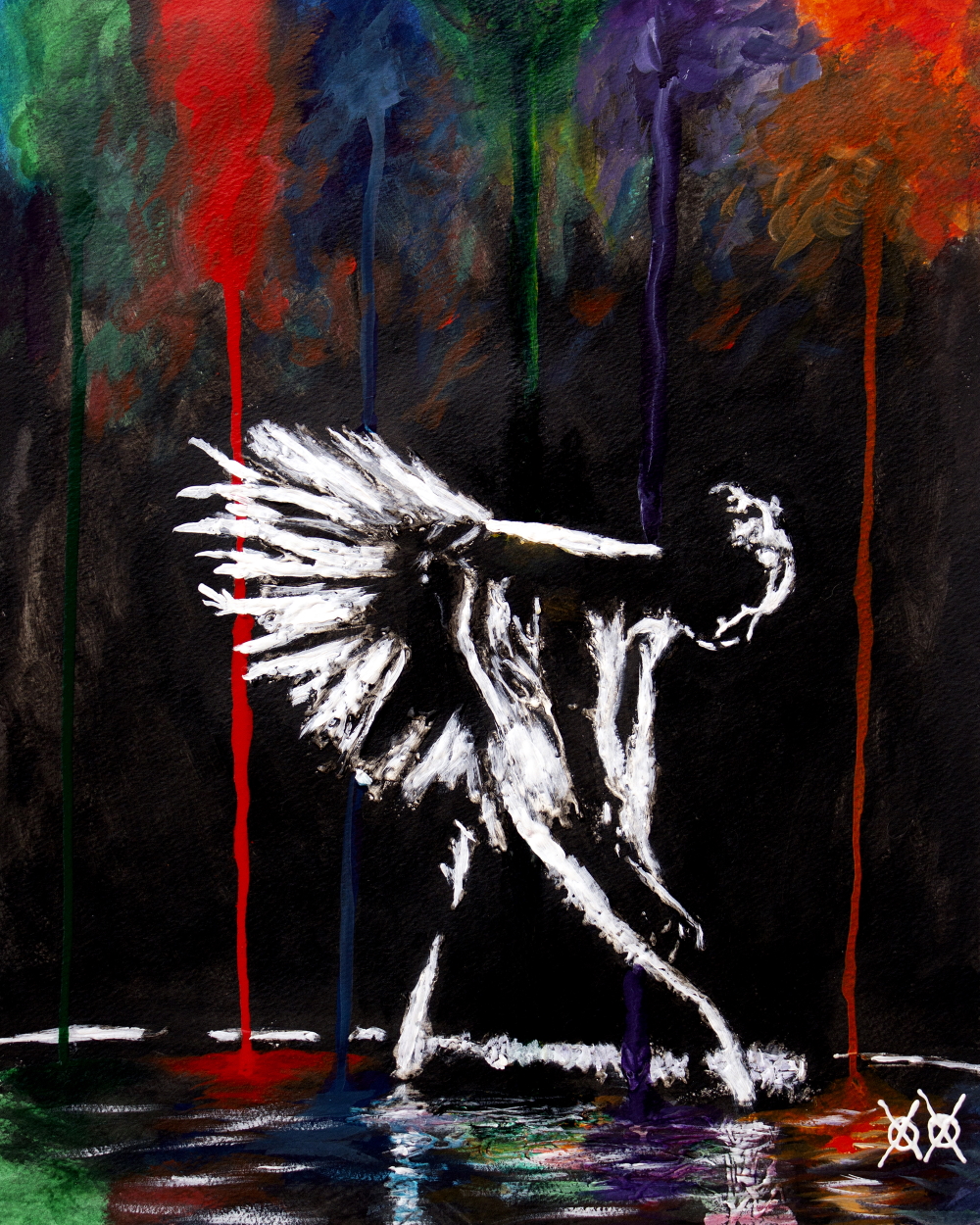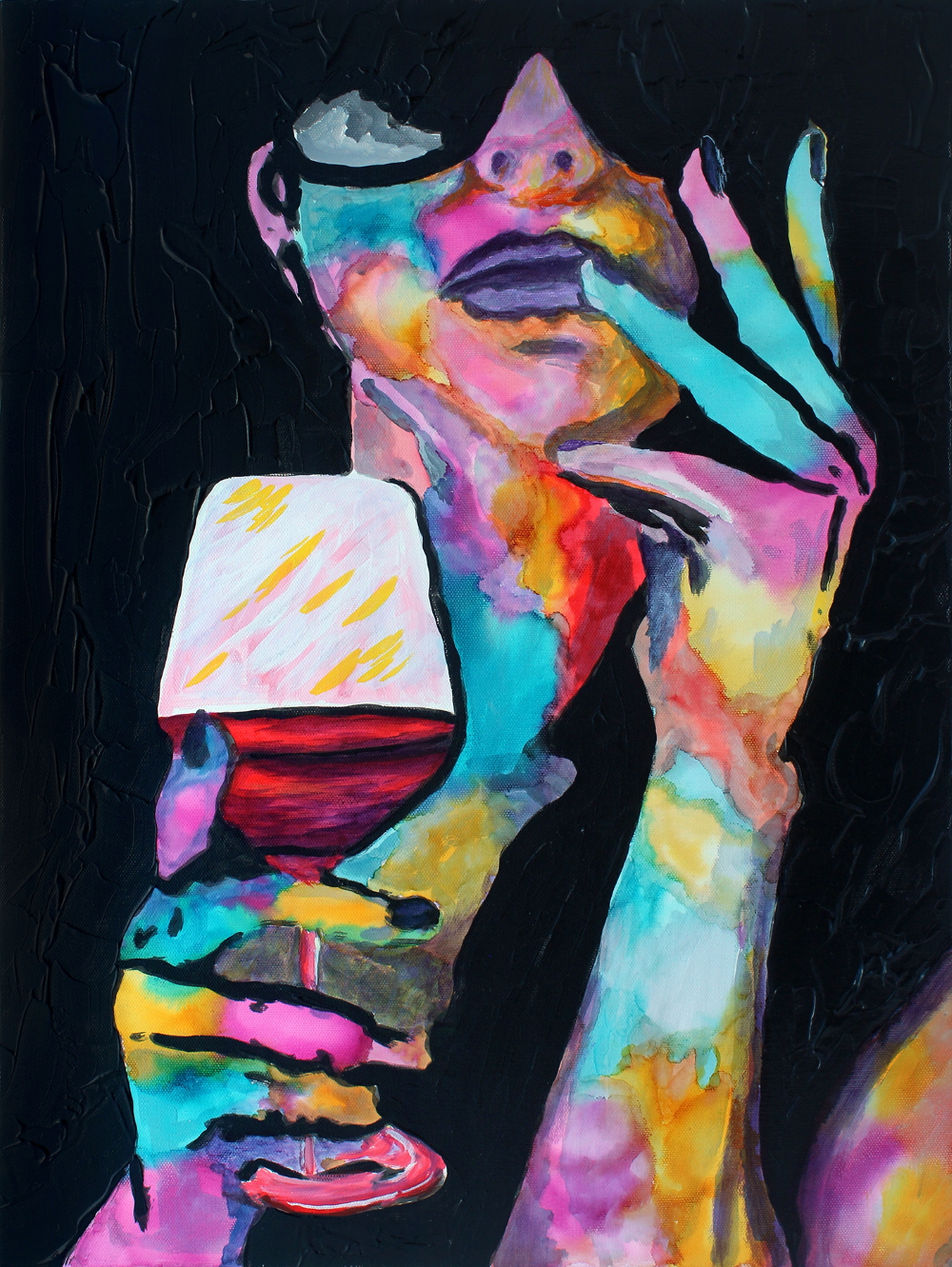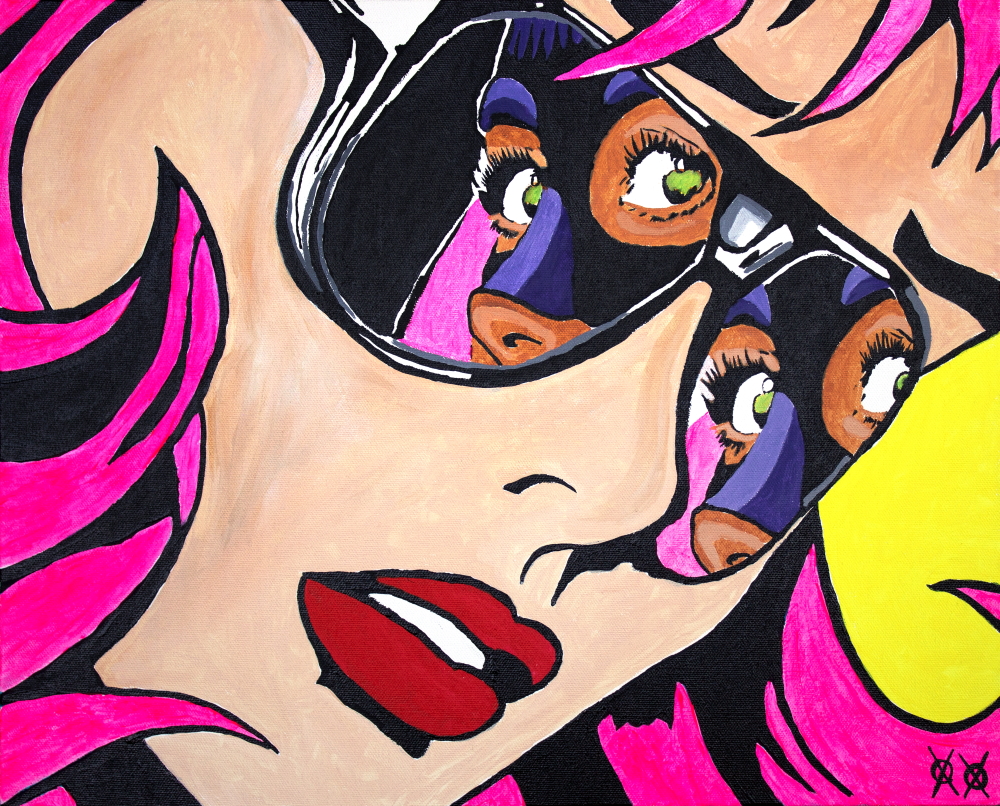John Bramblitt
the number one blind professional painter in the world
US
Nothing is impossible. The correctness of this statement is proven by the astonishing life story of John Bramblitt: The American is not only the number one blind professional painter in the world and surely the most popular but in addition the only blind muralist in the world with murals in New York and Dallas! The latter is four stories tall.
John Bramblitt
the number one blind professional painter in the world
US
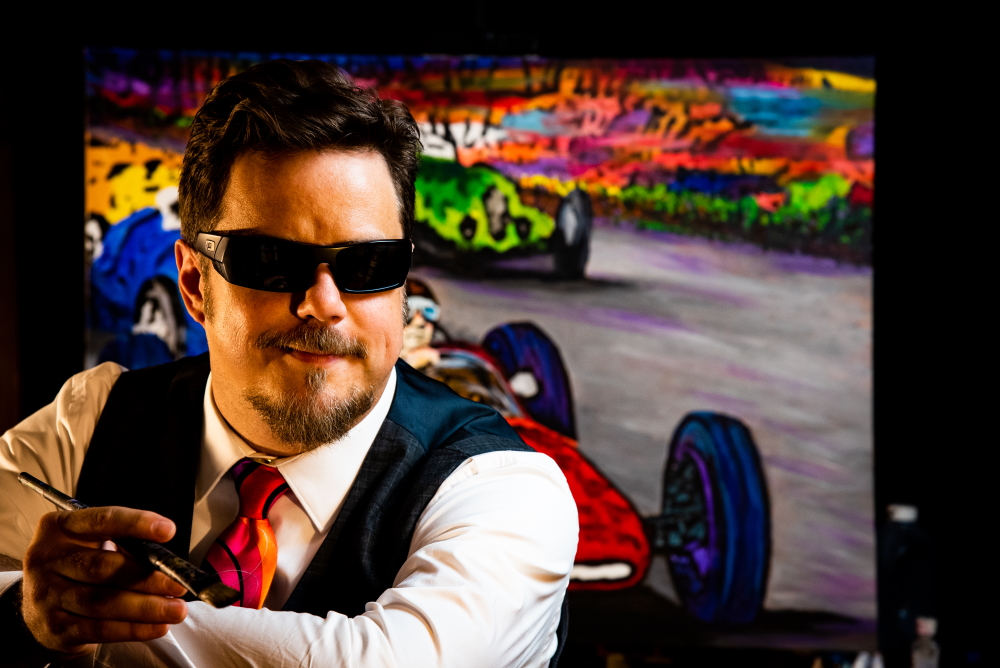
Prior to becoming a visual artist John Bramblitt (23 May 1971, El Paso/Texas) studied English at ‚The University of North Texas‘ in Denton and graduated. Having developed epilepsy aged two, he later developed Lymes disease, and complications from the two diseases together caused him to lose his sight in 2001.
"I began painting because I wanted to reconnect with people; to let people know even though I have epilepsy, even though I am blind, I'm still me in here", reads a quote from the British newspaper 'Daily Mail'. “I’ve drawn since I was really little, but I never painted until I lost my sight because I didn’t think I’d be good", Bramblitt told medium.com. "But here I was, without my sight, and my brain was filling up with images, and I couldn’t get them out. And I didn’t think I’d be able to do art again. But the trick is trying to get those images out of my brain." In memory of Albert Einstein’s quote "Imagination is more important than knowledge. Knowledge is limited. Imagination encircles the world”, he started to paint. How to do it was the hard bit in the beginning. But finally, a practical method was found. "I replace everything that the eyes would do for a sighted artist with the sense of touch", Mr. Bramblitt explained to twistedsifter.com. "The raised lines take care of finding your placement on the canvas.“ Then there are the colours that are made from different substances which have a viscosity and texture that varies slightly from color to color. By adding medians to the paint I can alter the way the paint feels even more.“ Because some paints have a very similar touch, all the bottles and paint tubes in his studio are brailled.
Typical of Bramblitt’s works are bright colours and an energetic style which is a mixture of Impressionism with a PopArt-feel. His art has gone to 20 countries around the world and he’s cooperated with internationally acclaimed museums like 'The Metropolitan Museum of Art' to run workshops teaching people to see the world as he does. For his seminars, he received three Presidential Services. Mr. Bramblitt was the subject of the award-winning documentary shorts 'Line of Sight' and 'Bramblitt'. He is the author of the book 'Shouting in the Dark: My Journey Back to the Light'. The man, who is known for his interactive events, lectures, and free art workshops, furthermore works as a consultant for museums in developing programs that are designed to include everyone – no matter their ability or disability.
John Bramblitt works and lives with his wife, son, and guide dog in Denton, Texas.
Interview April 2022
Innervisions: being blind, painting professionally
ABOUT INTUITION & IMAGINATION
How does intuition present itself – being a gut feeling or a suspicious impression?
Most of the time when I‘m about to start a painting or a piece of art it is something like an exciting sort of feeling. It is almost like energy. It is like I get a spark of energy. You could call it a gut feeling, but it is sort of both. That makes me really curious. It makes me want to try it out, to actually get to work. If there is something that makes me really curious, really interested in, that is how it presents itself.
Intuition is different for everybody. We’re all trying to find our own voice, colour, own sound. What works for one person, may not work for another. What works for me this morning might not work for me this afternoon. It is a very flexible sort of thing. Keeping an open mind I think is key.
Do you visualize something spontaneously in your mind’s eye - maybe in dreams?
Yeah, constantly. Whenever I lost my eyesight I thought I would forget what colour looked like. I thought I would forget what everything looked like. But I didn’t really understand how the brain works. How imagination and visualization work. How dreams work. So the part of my brain that imagines and holds images still works completely fine. It is just that my eyes don’t work. So I take in information in different ways. I use my hands to do the work that my eyes used to do, but I’m constantly, constantly imagining things. Whenever I hear music I see colour. So in my studio I have music playing all the time that matches the emotions, the feeling that I want. The entire being on my studio is coloured constantly. Life around me is full of it. Part of my work, my job is to take some of that colour and get it down on canvas.
Will any ideas be written down immediately and archived?
Yes, I’ve always done this. I have hundreds of pages of notes on my computer. I write down all kind of ideas. This helps you to work out things later and to connect ideas together.
What if there is a deadline, but no intuition? Does the first fuel the latter maybe?
I‘ve never missed a deadline. But I never accept a project unless I’m really excited about it and I have an idea. I mean I know how it’s gonna happen. When I painted the 737 or did my first four-story-mural I didn’t know how I was get it done, but I knew I could do it.
Are great ideas based on intuition or by almost endless trials and errors that result in constant developments up until the final result?
I think great ideas they come to you. Sometimes it’s almost like they‘re coming from another place. It’s almost like a dream. They come from inside you somewhere. Intuition is the same way with ideas. There is some part of you that’s wanting to say something. But in order to get that out, because it is sort of hidden, the trial and error part is really important. I think you have to fail a lot with art! If you’re not failing then you’re not trying to do new stuff!
World-famous guitarist Carlos Santana said to me, when the “sky” opens and sends you a brainwave one has to grab that special spiritual moment for realising it before the clouds darken all again. What do you think about that?
I think that’s so true. I read once for Hemingway said that sometimes he writes the story and sometimes the story writes him. I think you have to be present every day, if you’re a painter. You’ve gotta be with your paints every day. You’ve gotta be painting. You’ve gotta be at the easle working. Sometimes you’re pushing the paint along. Sometimes you’re sweating hard and you’re working hard just trying to get the ideas out there. But you’re available, you’re there. Other days it just flows out of you. And whether it’s flowing out of you or whether you‘re having to push it along, I think it’s the work that‘s important. You’ve gotta be available for it. You have to be in the spot, ready to take in the messages when they come. If I’m not at the easle and I don’t have my paints, but suddenly have that great clearity of idea, I cannot capture it in the same way than I was there. So I paint every day.
Does every idea exist immaterially already and just has to be put into effect, i.e. is creativity in its profound purpose basically about transferring dreams into reality?
Whenever I lost my eyesight my idea perception completely changed. Lot of times people think seeing is believing or if you don’t understand something one says ‚Oh, you’re blind to it‘. A lot of our living, our life, our growing, educating ourselves, our communicating with other people is us trying to understand the world around us and our place in it. Trying to understand ourselves. The world around us is our mirror that we look into to actually see ourself and to get an idea who we are. Whenever we have an emotion and we reflect of another person we have a better idea of what that means. I think reality is out there, we’re just trying to understand it. And the more that we try to understand our dreams – reality reflects in our dreams – the more we try to understand our thoughts, ideas, emotions, the better we understand the reality that is all around us and we’re all interacting. I’m just trying to meet up a little bit the reality and the eternal world. But it goes both ways. Art is our way trying to understand it.
ABOUT INSPIRATION
What inspires you and how do you stimulate this special form of imaginativeness?
People inspire me. Music inspires me. Whenever I hear colour, I see music. Since I don’t get colour from my eyes anymore, music is where I get it from. So most of my paintings are music paintings. And I love meeting people. Most of the people in my paintings are real people – friends of mine or people that I meet. I feel their faces. There is a technique to take a person’s face and almost work it like a composition where you‘re breaking it down into areas. So I can feel these areas and feel the faces and understand what they look like. I use all of this to form my paintings. All that is just like the fuel for the fire and the fuel is always coming.
Do calm and relaxation prove the most suitable or does pressure fire up creativity?
I think you need a balance and by that I don’t mean to be right in between relaxed and fired up. I think you need both. There is time where your brain needs to rest and sometimes where your creativity is at pure force. Having both of it and being able to find that middle ground is well.
How do you separate the good from the bad and which ideas are worthwhile to be explored further or whether one idea has the potential of being outstanding really?
Before I do a painting I always paint it out in my mind first. I work up the composition. I work up the layers. I work out which way a person’s eyes will track across the canvas. Because the way you draw the composition, the way you use colours, you can drag that. It’s like a small film. If all of that is coming together I feel like Yes, I gotta do this painting. Generally my problem is that I’m having an idea for a painting and I have four, five, six ways I wanna do it. I have to get it down to the one I’m most excited about. Sometimes I can’t do that. I get two different ways of doing the painting. Then I have to do two paintings and let them work out from there.
What key characteristic does an idea need to be viable i.e. does it have to appeal to you personally or promise commercial potential/fulfil certain needs?
It has to appeal to me personally. I’ve found that I’m not a commercial artist. I’m a studio artist. I do a lot of commission work. I do murals, I do stuff for galleries and museums. I’m constantly selling, but I’m not like a graphic artist, even I have so much respect for them. For me art is always my way of dealing with things. It’s my way of visualizing the world and expressing and communicating.
The reason for me that I paint is very personal. All of my paintings have to come from a spot that excites me. This always hasn‘t to be serious. I paint really cute stuff for fun and that makes me giggle a little bit. But then I paint some serious stuff too. I paint all kind of different things, but not all art has to be so serious. It has to be personally interesting to me. I found if I try to push outside that border, the art isn’t as good. I’m fortunate that I can pick projects that inspire me personally. I turn down a lot things, even if they are really interesting and might be good for me from a business or money standpoint, when I don’t think that I’ll be the best artist for it. I turn it down even it is a hard thing to do, because it is not personally appealing.
Does inspiration for you reveal itself in a kind of clear and complete vision so that you just have to capture the fantasy in a way that’s authentic to your creativity?
A lot of times I can get a very clear image or idea of what and in which technique I want to do it. It’s just like lightning. Bam! But it’s building on the shoulders of all these others ideas that I’m having and working on in the fact that I paint eight to twelve hours a day, every day. I’m constantly working on stuff so suddenly this inspiration seemingly strikes out of nowhere. I’ve got a pretty good idea that it is coming out of the work that I have put in. Things are coming together in the background subconsciously literally. So it does reveal itself that it suddenly pops up from behind the curtain, but usually it needs some editing too. It’s rare that it is just perfect the way it just comes out. In painting one has to work with techniques, different materials, so I have to figure out how I will take this artistic vision and actually make it into reality.
Do you sometimes revisit old(er) ideas (especially in tough times of need)?
Specially now that I’ve been painting for so long I can revist an idea that I did ten or fifteen years ago and see how it has changed. It is interesting just for me on a personal level how I think about things differently.
Because I’m blind and because I had to learn different ways to be able to visualize the world, the complexity that I’m able to see is constantly changing over the years. If you look at a painting that I did 20 years ago – it‘s of a person’s face – it is a very blocky, very geometric sort of a painting compared to a painting that I’m working on right now. There is a whole lot more detail, whole lot more colour. It has changed because my ability to visualize, I am using my sense of touch, is constantly changing. I’m always pushing forward, but it is really interesting to look back as well.
How long do you ponder an idea before creatively working on it?
Anywhere from seconds to years. Therefore I want to refer to my answer of a previous question, whether I take notes of ideas. I write down ideas. Sometimes it is ideas that I physically can’t do. Since I am the first blind professional painter in America and one of the first blind people painting in the world professionally, there wasn’t any compared visual artist really. There wasn’t something that was thought about before I started painting. So I had to come up with all the techniques by myself. I developed them over the last couple of decades. There wasn’t paint developed that way. There were no ways how to draw. I had to work out different ways of mixing paints and to work with colour through touch – with thick paint and thin paint, with lines that are there for a while, lines that go aways. Lines that are thick. Lines that are tacky on surfaces, that are smooth or roughy. I always have to understand where I am on the canvas and to work with colour. So there is a whole lot of thinking, but the ideas for the paintings usually come pretty quickly.
Do you check what colleagues/competitors are up to/your role models contrive(d)?
I love what other artists are doing. I don’t really have competitors. I help other artists. I train(ed) hundreds of professional painters. Everybody`s art is their own thing. So I don’t see other artists as competitors. Everybody puts their own thing out, so it’s true to them. If there is a buyer who likes somebody else’s painting, I’m not able to do that painting anyway, so I don’t really see the other person as a competitor. I work on my paintings.
I read all that I can about painting, colour theory and how other artists are working. I probably learn more about techniques from actually meeting other artists and touching their artwork especially when it’s thicker. How they work with paint knives. How they use colour. Asking them what they do on the canvas. I had to learn how to do shadow, because I can’t see light on the canvas. Learning how to paint shadow took some time and talking to colleagues was really helpful. Also how to paint black and white by using purple and blue. Knowing how other people solve their problems is awesome. When you’re painting you’re in your studio alone usually, so it’s nice to have contact with other people who are just obsessed with art as you are.
ABOUT CREATIVITY
Which time/place/environment suits your creative work process the best?
It doesn’t really matter. I paint every day and everywhere I go generally. When I’m sick I usually work out compositions and try to write them down. For me not painting would be for you like deciding to wear a blindfold for that day. Painting is for me my visualizing the world, my way of communicating. I travel a lot, so I have all kinds of art and paint kits that fit in suitcases: big ones, little ones and even a tiny art kit that fits in a bagpack whenever I go hicking, camping or kajaking. I paint on stage in front of thousands of people, I paint on tv in front of millions. In Holland, Japan, Canada or at shows that are broadcast in America. On stage with orchestras or with jazz bands. The reason that this works for me is because with my easle I feel like I’m at home. No matter where I am, if I have my canvas and my easle, it doesn’t matter what’s going on around me. Although in my studio I usually have music playing because I want colour in the air. So i usually have at least bluetooth or some kind of music playing when working away from home.
What does your average creative day look like (early bird or night worker)?
I generally work from 8 or 9 am, take a lunch break and work up until 6 pm. Then dinner with my family. On most days I go back at 9 pm and paint up until 2 am in the morning. I am so fortunate that my family is really happy with that. They come to the studio which is located at the back of my house and we can hang out while I’m painting. Of course my working hours are flexible, so we can do something together when we want to. Generally I paint like a crazy person.
How important are self-doubt and criticism (by others) during such a process?
You do care about what other people think, but on a real level I don’t. That is something you have to learn. I tell new painters: ‚Don’t show your artwork to anybody until you’re ready to not care what they say.‘ But that goes two ways because a lot of artists don’t think about that somebody praising your work is just as bad or as good as somebody that is putting a criticism. If somebody says while I’m working on a painting: ‚That is amazing, that is perfect.‘ Then I think: ‚Oh, you’re right. That is really great.‘ I won’t keep working on that area, that process, that technique anymore, because I think it‘s done. While if I just kept working on it then it might get even better. Maybe somebody doesn’t like something because they didn‘t understand the message that’s being said or they didn’t like that message. But maybe that’s really a great painting and you’re setting that message hard and that’s brilliant, but that person can’t hear it. So they are giving you criticism doesn’t mean that the art is bad, but for their own reasons they can’t take it in. So somebody saying words to you as an artist can effect the art and that’s something that you don’t wanna happen. I think there are two processes: The creative and the editing process. During the creative process create, create, create. Your brain can’t do two things at once. You can’t be fully creative and then start taking it away start editing, making chances. It is better to stay in the creative mode for a long time and then you can go back and take in the artwork. It is ok to be interested what other people have to say, but to take it in you don’t necessarily have to agree with it. Nothing is written in the stone. It is just that one person’s feeling about it. But it is information that you can take in. It is a little dangerous to worry too much about what other people think about your artwork.
Is it better to be creative on your own, only trust your own instincts, or in a team?
99.9% of all my art is just me working in the studio on commissions and different things. The only time I work in a team is when I’m doing murals. And that’s because the murals could be four stories tall. The teamwork comes in trying to physically get that painting on the wall then, but the composition of it is all me. In the studio it’s 100% all me, because noone else can really do that.
Does age/life experience help with creativity or is a younger mind more creative, ‘cos it’s fresh and untouched by experience? What about social/cultural heritage?
Every bit of information and energy that you can get - no matter where it comes from - adds to your art. The more of yourself you can put into your art, the more you get out it. Life experience is awesome. Any kind of experience, any kind of information, any kind of knowledge or creativity you can pull from anywhere is brilliant.
It doesn’t have to be that way that kids are more creative. You don’t have to be non-creative when you get older. You just gotta keep it up and keep practicing with it. It is interesting whenever you see an artist that is older and they’ve been painting since they were young and still have this amazing creativity and imagination that’s been homed over decades. But the older are not necessarily more creative than the younger persons, because then you get that unbridled creativity from a young artist and that is just incredible as well. So I think it doesn’t really matter. It‘s like wherever you can get the energy from.
For different people it could be different times. Some people are really creative when they are young and for some reason something happens and that goes away. For them being young and creative was the answer. For other people it is like a slow stain and they suddenly hit their stride. You see their creativity really blossom when they‘re older. For other people it is just like an ongoing train. They are imaginative and creative when they are young and they keep going and going.
I could draw before I could walk. It was just a normal kind of thing. It is just something I’ve always done.
If you’d make a pie-chart: what is your satisfaction based upon - a) self-realisation/ personal compliance, b) artistic recognition or c) commercial success & fame?
My favorite area in my studio is that big rack of paintings that is called by the joke name ‚my rack of shame‘. It has all these paintings that have mistakes on them. These are paintings that I started and had this idea but wasn’t able to get the idea to full realization: whether I didn’t know the technique well enough, I wasn’t at the point where I could mix the paints the way I needed to or whether the composition that I came up with wasn’t very good. But the brilliant thing about them all is that I learned from them. So from everyone of these paintings I learned a lesson. And I loved that. I’m obsessed with art and I love learning something about art. Having a canvas that doesn’t turn out would seem like a bad thing, but the ironic thing is that I actually get kind of happy. I am as happy as with such a painting like one that turns out the way I wanted it to be, because I paint for myself. I don’t feel like a painting is fully done up until it connects with somebody. It’s like reading a poem. You can stay in the middle of a forest, read the poetry and you’re putting art out there. But it has less of an impact than if someone hears and understands it. So whenever I‘m doing a painting, sending it out into the world and someone connects with it, then to me it is a very special sort of thing. It’s makes me really happy. It makes me feel very warm. It makes me feel like I’m being heard and it makes me feel like I’m not alone anymore. I don’t know whether that answers the question but that’s the huge part of the pie chart which is be me.
How does a creative find his/her own style/possibly unique way of expression?
Finding your own’s style is something you hear from a lot of artists and creatives early on. They are wondering ‚how is my style gonna be different from van Gogh or Monet or Andy Warhol or my art teacher or this person down the street that has that amazing style? How am I gonna express myself?‘ The best way, I think, is just work. Don’t worry about it. Work, work, work. Paint everything. Draw everything. If you’re a musician, play everything. If you are into blues, definetly play the blues, but also play jazz and play some rock. Play some polka. The reason I say that is because you can learn so many different angles and aspects of your art form. You need to get outside the box a little and you need to fail. I‘m constantly trying other kind of paintings. I was an oil painter for eight years and I am an acryl painter ever since. I paint in watercolour as well. I paint in this, in that style. I’m always trying different things. I just try to educate myself as an artist. And as you are working in more things your style comes out, because you‘ll choose one thing over another. You might like one form of expression more than another. You maybe like bright colours but not dark ones. Like Monet: he didn’t use black. That is a very personal thing. Most people use the colour black. But it is part of his style. You‘ll make decisions like that. Style is something that needs to develop and worrying about it doesn’t help. It just comes. It also develops over the years. So an artist might have a blue period. Style is something that isn’t necessarily static. An artist that is static gets kind of boring.
Is craftmanship important or should creatives be able to work 100% unloaded?
Craftmanship is really important depending on the artwork. If somebody buys an original painting of mine and they’re expecting an original painting thinking of traditional artwork to hang on the wall and it’s gonna stay there, that is what I wanna give them. I don’t wanna give them something that is gonna degrade in ten, twenty years and the colours gonna change or the paints gonna flake of. So knowing your materials and knowing how to work them is important. If I come up with a painting and want it to be good for centuries, I wanna have my craftmanship well enough to be able to do that. If I do a mural on a building and the building’s owner says ‚Paint whatever you want, but I’d like it to be there for thirty, fourty years‘, I want to understand how paint works on the brick. How bricks gonna carry that paint. How it breathes through the paint. If there are thunderstorms how’s that gonna affect it.
Can routine, experience and professionalism make up for lack of creativity?
There are a lot of graphic artists out there that are fine artists. They went to artschool, know how to draw certain things and put out a statement that’s great. But you’re never gonna hit that peak of a certain mountain top, you’re never gonna come up with a new sound, a new feeling, a new colour, a new way of expressing an idea without creativity. Experience, professionalism, routine is great to have, because without that reaching that mountain top is really difficult. Having all of them together is what you really want. After all: art is work. Hard work with creativity that’s a win.
If problems occur during the creativity or one’s stuck, how can that be solved?
Problems always gonna be there. They need to be there. If you get through a piece of artwork and you have it sweated out just a little bit, you haven’t pushed yourself creatively into new areas.
Here’s a little thing to not get stuck: If you don’t finish whatever you‘ve worked on that day and you leave with one little step undone, so the next morning when you come in and you are starting, you have that step to start. Because of that there is no dead time, you’re going. Before you finish one piece you’re gonna start another piece. So you constantly have something in the works. I usually work on two, three, four, five pieces at a time. If there is one piece I’m not sure what colour I wanna go here or I need to redraw or rethink this, I work on another piece. My brain is going creatively and later I go back to the previous one and work it out.
Are a never give up attitude and persistently hanging on necessities for creatives?
The first thing when I started painting after losing my eyesight for the first year I made that rule: I wouldn’t judge anything I did because I knew I would give up on the first painting! It was crazy. I thought I was out of my mind. Blind people didn’t paint. We’re talking the beginning of the year 2000. There wasn’t such a thing as blind painters. I thought I was nuts. I was really angry. I was depressed. My health was really bad. I just needed something to help me with the depression. When I was growing up I was in hospitals a lot and art has always been a wonderful way to deal with a bad day and a great way to celebrate a good day. I knew I just needed the act of creating art. Whether it turned out or not didn’t really matter, I just had to keep doing it. If you judge it too much, you‘ll get into your own way and you would never be able to push past it. I was very, very slow to start. It would take me a month to do a painting and at that time I was painting twelve to sixteen hours a day at least - every day, seven days a week. And things got better. Yeah, you can’t give up. If you give up you’re not doing anymore. So not giving up is a good step.
Which is better in the development process: speed and – if that’s possible - force creativity i.e. grasp the magic of the moment, or a slow, ripening process when it comes to implementation and elaboration?
It depends on the project and what you’re trying to say. I did a series of ten fairly large paintings for a university. I called it ‚the movement‘-series because it was based on music. I did the entire series in two weeks. That was really fast for me. It was almost a painting a day. I was working almost around the clock. But I wanted it to be done in one movement. Each painting should be as closely connected to each as possible. They are all done as much in the same timeframe as they could. It was exhausting, but it worked very well for that series. I was able to use time as a factor in that series. Other paintings take two, three days or one, two weeks. Cezanne would work a painting and then might put it aside for a month or a year, go back, look at it and make some tweaks, put it aside again. I have a painting of singer Janis Joplin that I worked on probably three years ago. I have it back in the studio now, because I’m making little tweaks on it. Coming back to the question: There isn’t any right or wrong. It is just knowing time and being able to incorporate it in your artwork. Being conscious of it can be kind of good. It can help change the artwork a little.
„Creativity is the ability to reorganise known factors so that they become novel and fresh.“ Do you agree with British rock-manager Tony Stratton-Smith?
Yeah, I think that is really true. Take „Star Wars“ for example that blew many peoples‘ minds. It’s just like an old Greek or Roman tale. The tools that we use nowadays are different for the most part but the experiences, the emotions that we have are the same. If you could drop people from the past into the world now they would be dealing with the same emotions. It is interesting to take inspiration from really amazing people how they took in the world in the past and use that as inspiration and maybe be able to see the world around us in new ways. Isn’t that what art is all about?
Should a creative always remain true to him-/herself including taking risks & going against the flow or must one, for reasons of (commercial) survival, make concessions to the demands of the market, the wishes of clients and the audience’s expectations?
I definitely understand why a commercial artist will need to meet the expectations of the client. He is selling himself as someone to deliver a particular service, to sell the product. That’s the whole reason he‘s there. As a fine artist like me, even that sounds pretentious, I do it because art was what has saved me.
How is innovation still possible if one has established a distinctive style?
Styles change over years the more that you learn, the more that you’re exposed to, the more that you’re experienced with. All that’s gonna change the way you think. And art is just a reflection of one’s life. As your life changes, your art changes. So your style is going to change as well. The only time it doesn’t is when you get stuck.
In case of failure or - worse - a creativity crisis how do you get out of such a hole?
I love failures. Failure is great fuel. It is fuel for the fire of your creativity. I think of creativity like an engine: it will burn anything. Useful creativity will burn your mind, your imagination, inspiration, failure, success. It will take anything that you wanna feed into your imagination and use it as fuel. So if I have a failure it is just more fuel for the fire to throw in and keep working. But the main thing is: iust keep working! If you feel depressed and sad and you almost can’t lift the brush, remember: a brush doesn’t weight that much! You can pick it up and start making a mark on the canvas. If that’s gonna suck and you’re gonna hate it, that is way better than not doing anything. And you’ll feel better about it even if at the end of the day you‘ve just put a bunch of ugly marks on the canvas. You did that! That is better than not doing it and feeling terrible! You’ve done better than nothing! And when you keep doing that it’s eventually going to add into something.
Did you ever deliver something that you considered mediocre, but was successful?
That is hard to say. I really do try different techniques on pretty much every painting I do. Every painting that I do and put out I’m happy with it at the time. Later on you go back and think ‚Oh my gosh that painting is five years old, that technique is so much better now or I’m able to handle colour so much better now‘. Sometimes I feel myself getting a little embarrassed and think ‚I wish I could hide that‘‚ but then remember too: It is not all about you. That painting is a snapshot into time of my life as an artist. That is how I was feeling at that time. That was the best work that I could do. I tried my best on it. I did my best. If it is not the best work that I’ve ever done that is why I’m still painting. I’m constantly trying to make it better. I always try to come up with a true painting.
ABOUT SUCCESS
Why are some people successful and others not - despite the same talents?
A lot of the many reasons don’t deal with the artists themselves: it could be the environment that you’re in, could be the people around you that hold you back a little bit. The main reason, and that is bigger than all the others put together, is that you’re holding yourself back. That is huge with creatives. Creative people are some of the nicest, imaginative and fun people you’ll ever meet. They are, generally speaking with the obvious exceptions, so kind to everyone around them. But they are not that way to themselves. They are really, really hard on their own work and their own failings in it. They take their failures and blow them out. They wouldn’t do that with someone else. To avoid that mentioned problem you gotta get out of your head. You are your own worst enemy. Just stop judging for a minute. Give yourself a break. If you’re in the act of creating, you are an artist creating. You can’t put on all these other hats. You can’t judge your social media skills, you can’t judge your use of every aspect of every technique you’re doing. If you do that you gonna hold yourself back.
Should/can one resist the temptation to recycle a ‘formula’ one’s successful with?
For me I don’t know whether it is a formula that whenever I (as a blind person) hear music I see colour. Maybe it is. I don’t know. If something is pushing you forward creatively, if it is helping you to get work done, if it keeps you busy, if you’re inspired by it, if you’re happy with it, if you still have that buzz of energy while you’re doing it, then I think it’s ok. If you’re bored with it: why are you doing it? If it bores you, stop doin‘ it! Do something you’re excited about. I think you’ll be much more successful and much happier for sure.
Is it desirable to create the ultimate/timeless work, but doesn’t “top of the ladder” bring up the question of “what’s next?” i.e. isn’t such a personal peak “the end”?
That is not something you have to worry about really. Whenever you’re dead and gone, you’re dust in the grave, art critics and people and collectors are looking at your work - they’ll decide for themselves which piece was your best painting.
If I would be able to do that one-time-piece and afterwards have to stop painting – no! I keep doing it. And what’s next is your next true painting!
MY FAVORITE WORK
„I don't really have a favorite painting. I get asked that a lot and the painting that is my favorite is always the one I am currently working on. It tends to be more about the process than the end result for me.“
